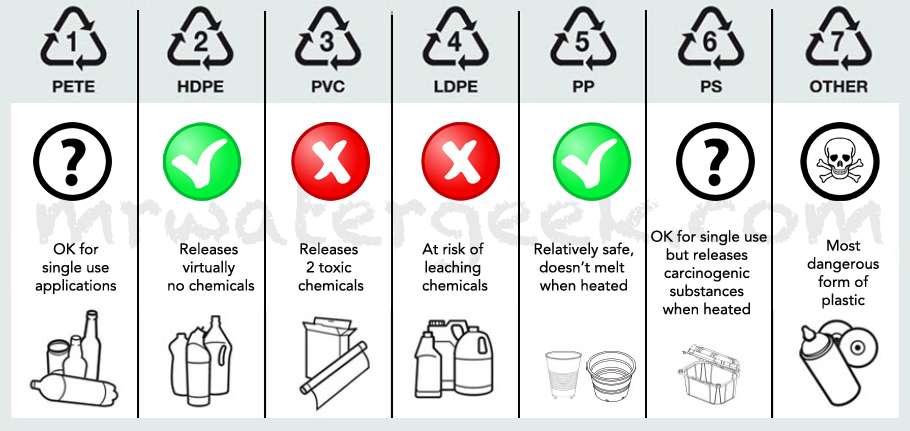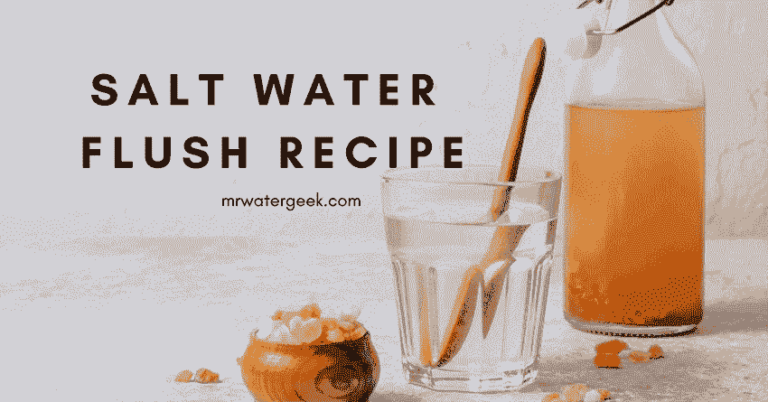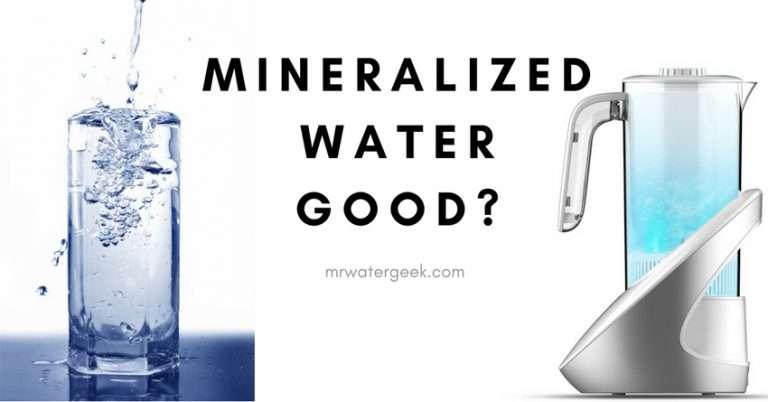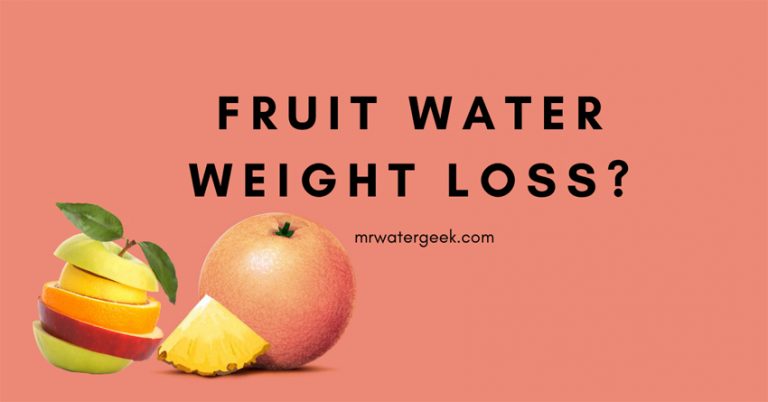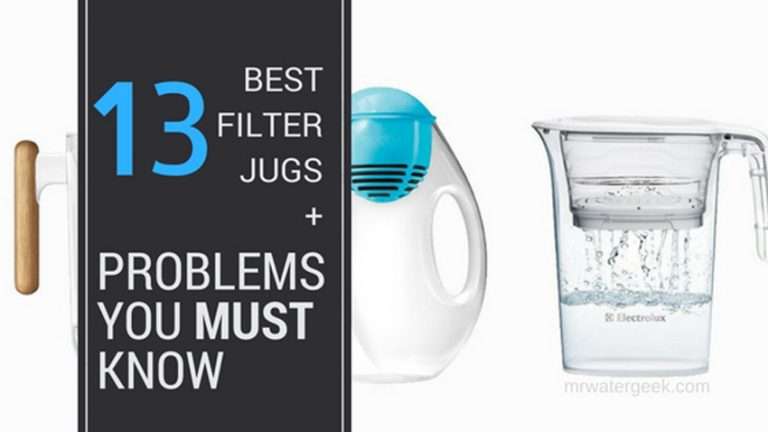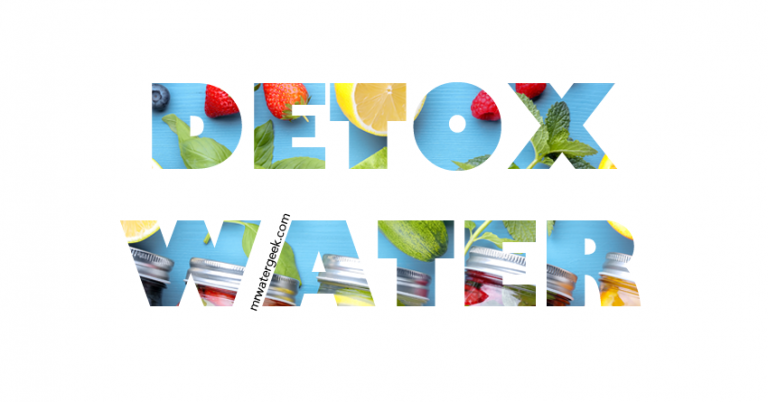AVOID Plastic Poisoning: Check Bottled Water For BPA
Check Bottled Water For BPA
The fastest way to check for BPA is to look for the identification code sometimes called the RIS (Resin Identification Code). BPA-safe bottles will only use codes 1, 2 or 5. To find this code turn the bottle upside down and look for the number in the recycling symbol.
What Do Plastic Resin Identification Codes Mean?
Here is a quick graphic to explain what the different codes mean:
Here is a simple snapshot of what the different symbols mean in terms of actual health risks:
PETE or PET
PET is good for single use applications. If you use it repeatedly then you are at serious risk of bacterial growth and leaching. Bottle refilling and putting it in the microwave is a no-no.
HDPE
The HDPE plastic releases virtually no chemicals, which makes it one of the safest plastics to use.
PVC or 3V
PVC or 3V releases 2 toxic chemicals. Both of which affect the hormones in your body. Experts suggest you should buy an alternative if possible.
LDPE
Experts say that you should avoid eating food packaged in LDPE plastics because they are at a small risk of leaching chemicals.
PP
PP does not melt when heated and as a result it is relatively safe for this purpose as well as long term use.
PS
PS plastic release carcinogenic substances when heated and is completely unsuitable for long-term use as a drink or food container.
PC or non-labeled plastic or ‘other plastics’
PC and other plastics are the most dangerous form of plastic you will encounter so should be avoided at all costs.
What You Must Check Before You Buy Bottled Water
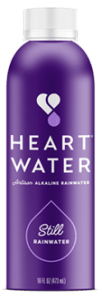 First things first, always check bottled water for BPA. Secondly, bottled water is one of the worst choices you can make when it comes to buying water.
First things first, always check bottled water for BPA. Secondly, bottled water is one of the worst choices you can make when it comes to buying water.
I have written about this extensively in a marathon 2-thousand word essay. The article looks at all the issues including things like the BPA contamination of plastic bottles and the environmental cost.
Also, the world recently started understanding that some of the bottled water you buy at a premium is nothing more than tap water itself.
However, let’s say you no other option but to buy bottled water then at least you are equipping yourself to make an informed decision about what you buy.
Start by looking for the symbol on your bottle, it is usually located on the bottom if it is a generic water bottle.
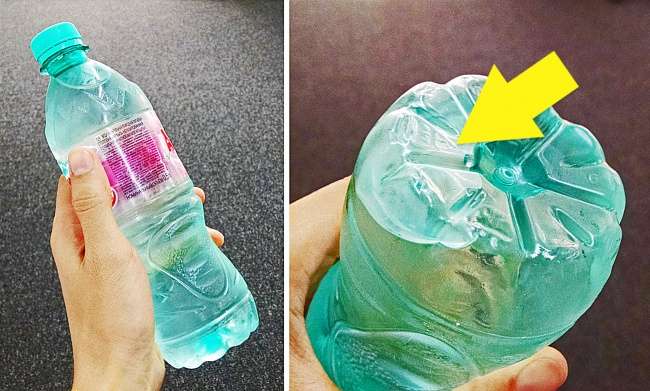
Water bottle plastics are different depending on which brand you buy? Chances are that you have never learned what all this means. It is unlikely you know what the different type of plastics are and how they can impact your health.
But when you check bottled water for BPA know the law is on your side. Strong legislation means that every single kind of plastic comes with an indication of what specific type of plastic it is.
It is important you know and understand what this means. This is because the type of chemicals contained in plastics can cause varying degrees of harm to your body.
![]()
Do-It-Yourself Bisphenol A Detection (BPA) Check
Here is the complete guide to all the symbols used for plastic so that you can quickly and easily check plastics for any BPA.
Check Bottled Water For BPA
Every plastic bottle will have one of the following graphic labels on its body, usually located at the bottom and underneath:
Now let’s look at what all this coded jargon actually means so that you can always check bottled water for BPA….
PETE or PET
PET is one of the most common plastics used in many consumer products. It is he kind that you will find on most soft drinks, water bottles as well as other forms of packaging.
PET is good for single use applications. If you use it repeatedly then you are at serious risk of bacterial growth and leaching. Bottle refilling and putting it in the microwave is a no-no.
Bottles made from PET plastic can release chemicals and heavy metals, which affect your hormonal balance. Also note that this type of plastic is very difficult to safely decontaminate and if you want to clean it properly then you will need to use chemicals that are harmful.
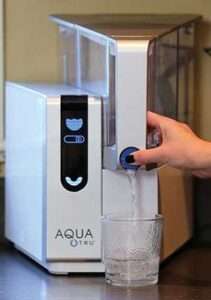 HDPE
HDPE
HDPE is essentially the hard plastic used for oil bottles, detergents, toys, milk jugs, and some plastic bags. The HDPE plastic releases virtually no chemicals. Experts say that it is always better to choose HDPE when you buy bottled water. This is because they are probably the safest and as a result likely to contain the cleanest water you can buy.
PVC or 3V
When you check bottled water for BPA it will be easy to spot PVC plastic.
Why?
Because PVC is a type of plastic that most of us are familiar with.
It is the pliable, soft, flexible plastic. PVC is in things like cooking oil bottles, clear plastic food wrapping, teething rings, toys and many other consumer products.
You might be surprised to know that it releases 2 toxic chemicals.
Both of which affect the hormones in your body. Experts suggest you should buy an alternative if possible.
LDPE
This type of plastic can not be used to make water bottles, this is despite the fact that there is no evidence that it releases chemicals into the water.
However, this is not the case with food packaging.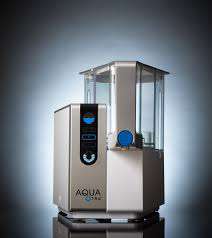
Experts say that you should avoid eating food packaged in LDPE plastics because they are at risk of leaching chemicals.
PP
The letters “PP” is code name for a white-colored or semi transparent plastic that is typically used to package things like yogurt cups and syrups.
PP stands for “Polypropylene” and this type of plastic is both lightweight and tough giving it its excellent heat-resistance qualities.
This means that this plastic doesn’t melt when heated and as a result it is relatively safe. Its strength also means that it has a good barrier against chemicals, grease and moisture.
PS
PS stands for “polystyrene” and it is a relatively lightweight, inexpensive plastic which has innumerable uses.
You have most likely come across it in the form of a disposable styrofoam drinking cup. They appear in things like egg cartons, take away food containers, or disposable plastic cutlery.
PS plastic release carcinogenic substances when heated and is totally unsuitable for long-term use as a drink or food container.
PC or non-labeled plastic or ‘other plastics’
When checking bottled water for BPA remember that plastics that are not labeled fall under the PC (polycarbonate) category.
In order words, “PC” is a catch-all term for all the remaining types of plastics. As a result, it does not conform to the standard reuse and recycling protocols.
PC and other plastics are the most dangerous form of plastic you will encounter so should be avoided at all costs.
Be weary because PC plastics often appear in food containers and sport water bottles. The biggest concern is the potential that harmful chemicals will leach from the plastic. Perhaps leach into your drink or food products.
Note that polycarbonate containers are usually made with BPA (Bisphenol A).
Scientific References
Watanabe I. Harada K. Matsui T. Miyasaka H. Okuhata H. Tanaka S. Nakayama H. Kato K. Bamba T. Hirata K.”Characterization of bisphenol A metabolites produced by Portulaca oleracea cv. by liquid chromatography coupled with tandem mass spectrometry”, Biotechnology & Biochemistry, 76(5):1015–7, 2012.
Midoro-Horiuti T, Tiwari R, Watson CS, Goldblum RM (2010). “Maternal bisphenol a exposure promotes the development of experimental asthma in mouse pups”. Environmental Health Perspectives. 118 (2): 273–7.
“A Survey of Bisphenol A in U.S. Canned Foods”. Environmental Working Group. 5 March 2007. Retrieved 2 February 2012.
Rubin BS (2011). “Bisphenol A: An endocrine disruptor with widespread exposure and multiple effects”. J.Steroid Biochem.Mol.Bio. 127 (1–2): 27–34.

